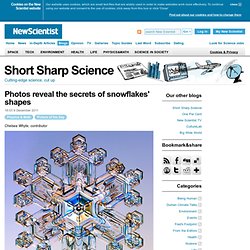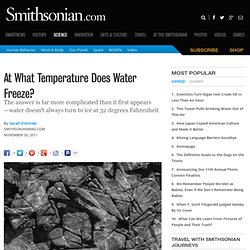

Chemical Reactions Shot in Ultra HD Look Like Alien Life. The Cutest Little Doll-Shaped Molecules You Ever Did See : Discoblog. Infinity Imagined. D.I.Y. Graphene: How to Make One-Atom-Thick Carbon Layers With Sticky Tape: Scientific American Slideshows. Graphene: The Pencil Material That Will Revolutionize Our Lives [Video] For materials-science fans, graphene is one of those substances that's easy to get excited about.
![Graphene: The Pencil Material That Will Revolutionize Our Lives [Video]](http://cdn.pearltrees.com/s/pic/th/revolutionize-scientific-82179514)
Not only is graphene transparent and superstrong—a sheet with the thickness of Saran Wrap could support an elephant—but it also conducts electricity very quickly. It could lead to computer circuits that run 100 times faster. Ainissa Ramirez, a Yale University professor of mechanical engineering and materials science, explains the basics of graphene and demonstrates its electrical property with pencil marks on paper.
The video is part of her "Material Marvels" series. One of the discoverers of graphene, Andre Geim, won the 2010 Nobel prize in physics (he indeed used adhesive tape on graphite to make graphene) and wrote about his work in his article, "Carbon Wonderland," in the April 2008 Scientific American (subscription required). If you feel inspired, you might want to click on over to this: D.I.Y. Infinity Imagined. Photos reveal the secrets of snowflakes' shapes. Chelsea Whyte, contributor (Image: SnowCrystals.com) Did you know that snowflakes grow?

They all start as a hexagonal crystal of ice and then spread out, forming delicate arms and enchantingly intricate patterns. It's long been known that different temperatures influence the patterns of ice crystal growth. At What Temperature Does Water Freeze? The title of this post would seem an appropriate question for an elementary-school science exam, but the answer is far more complicated than it first appears.

We’ve all been taught that water freezes at 32 degrees Fahrenheit, 0 degrees Celsius, 273.15 Kelvin. That’s not always the case, though. Scientists have found liquid water as cold as -40 degrees F in clouds and even cooled water down to -42 degrees F in the lab. How low could they go? That turns out to be a tricky problem to answer. As the temperature of the water approaches -55 degrees F, the water molecules form tetrahedrons, with each molecule loosely bonding to four other molecules.
This supercooling of water is possible because water needs a small nucleus or seed of ice for the molecules to form crystals and in very pure water “the only way you can form a nucleus is by spontaneously changing the structure of the liquid,” Molinero says. (HT: io9) Georgina Ferry on X-ray crystallography. 10 Unsolved Mysteries in Chemistry. The Elements Revealed: An Interactive Periodic Table.
In the October 2011 issue of Scientific American, we celebrate the International Year of Chemistry. Learn more about its impact on our daily lives in our Special Report. UPDATED: 06/18/2013 In honor of the 2013 Lindau meeting, which focuses on chemistry, we have updated our interactive periodic table with links to Nature Chemistry's In Your Element essay series. Each essay tells the story of a particular element, often describing its discovery, history and eventual uses. Main Sources & More to Explore: The Poisoner’s Handbook: Murder and the Birth of Forensic Medicine in Jazz Age New York. Interactive by Krista Fuentes Davide Castelvecchi Davide Castelvecchi is a freelance science writer based in Rome and a contributing editor for Scientific American magazine.